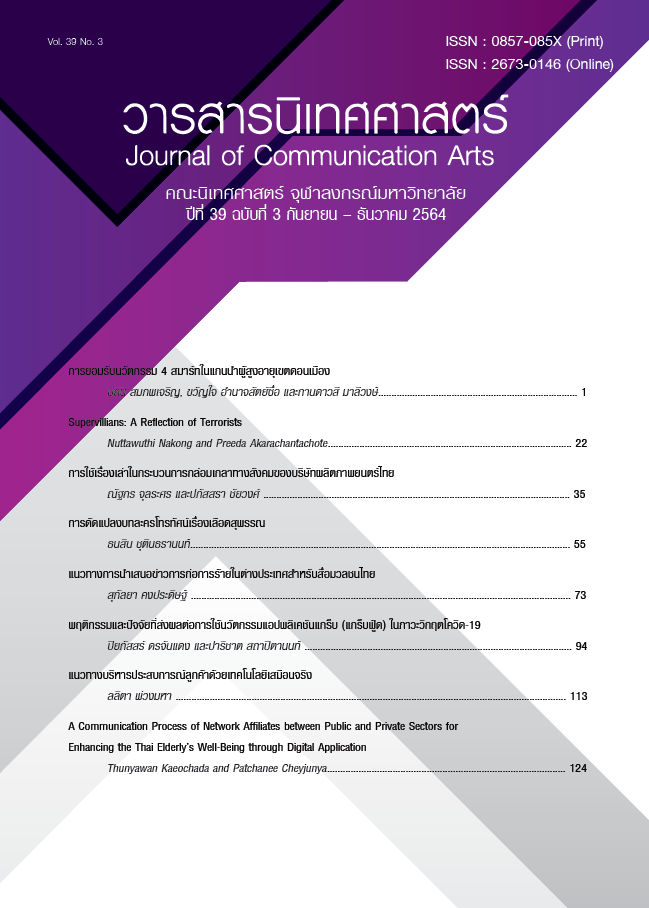The Use of Narratives in Organizational Socialization Process in A Thai Film Production House
Main Article Content
Abstract
This qualitative research was aimed at studying the narratives used in the organizational socialization process and the new employees’ perception towards the narratives. The data were mainly gathered through in-depth interviews with 16 participants, including the executives and the new employees, and through participatory observation.
The results revealed as follows: The organization’s culture and core values reflected in the narratives shared with the employees consisted of hedonism, a family of professionals, and the belief in supernatural power. The value of a family of professionals was implied through fraternal practices as well as the home-like office design. In terms of the belief in supernatural power, the executives adopted this value later so as to cope with the unpredictable situations in this industry. In addition, it was found that the narratives used in the organizational socialization process corresponded with the organization’s culture and core values, background, mistakes, lessons learned, achievements, collective pride, and belief in supernatural power. The narrative used in the socialization tactics was applied at both the individual and the collective settings, in both the formal and the informal settings, and at both the serial and the variable settings. With regard to the new employees’ perception, the new employees perceived the organization’s culture and core values, namely the belief in supernatural power, a family of professionals, and hedonism respectively. Concerning the acceptance and meaning negotiation following the socialization process, there were both the employees who accepted and rejected the organization’s culture and core values, and there were both employees who preferred to continue and preferred to discontinue working for the organization.
Article Details
References
จตุรงค์ นภาธร. (2560). การบริหารพนักงานหลากหลายกลุ่มวัย (Managing A Multi-GenerationalWorkforce). กรุงเทพฯ : สำนักพิมพ์มหาวิทยาลัยธรรมศาสตร์.
เดชา เดชะวัฒนไพศาล. (2552). การรับรู้คุณลักษณะของเจนเนอเรชั่นวายและแรงจูงใจในการทำงาน: มุมมองระหว่างเจนเนอเรชั่นต่าง ๆ. จุฬาลงกรณ์ธุรกิจปริทัศน์, 31(121) ก.ค.-ก.ย. 52.
ณปภัช นาคเจือทอง. (2553). การศึกษาปัจจัยที่มีผลต่อแนวโน้มการลาออกของพนักงานใน อุตสาหกรรมโรจนะ จังหวัดพระนครศรีอยุธยา. การศึกษาเฉพาะบุคคล บริหารธุรกิจบัณฑิต มหาวิทยาลัยกรุงเทพ.
อุบลรัตน์ ศิริยุวศักดิ์, ถิรนันท์ อนวัชศิริวงศ์ และศุจีรา สุวีรานนท์. (2542). จินตทัศน์ทางสังคมในภาษาสื่อมวลชน. โครงการสื่อสันติภาพ คณะนิเทศศาสตร์ จุฬาลงกรณ์มหาวิทยาลัย.
Boje, D. (1991). Consulting and Change in the Storytelling Organization. Journal of Organizational Change Management, 4(3), 7-17.
Boje, D. (1995). Stories of the Storytelling Organization: A postmodern Analysis of Disney as Tamara- Land. Academy of Management Journal, 38(4), 997-1035.
Campbell, J. (1973). The Hero’s with a Thousand Faces (3 ed). New Jersey: Princeton University Press.
Champoux, J. E. (2000). Organizational Behavior: Essential Tenets for a New Millennium. Singapore: South-Western Collage Publishing.
Deal, T. E., & Kennedy, A. A. (1991). Corporate cultures; The rites and rituals of corporate life. New York: Addison Wesley.
Garavan, T.N. & Morley, M. (1997). The Socialization of High-Potential Graduates into The Organization: Initial Expectations, Experiences and Outcomes. Journal of Managerial Psychology, 12(2), 118-137.
Giddens, A. (1991). Modern and self-identify: self and society in the late modern age. Stanford, California: Stanford University Press.
Gordon, J. R. (1999). Organizational Behavior: A Diagnostic Approach. 6th ed. Upper Saddle River, NJ: Prentice Hall.
Hofstede, G., Neuijen, B., Ohayav D. D., & Sanders, G. (1990). Measuring organizational cultures: A Qualitative and quantitative study across twenty cases. Administrative Science Quarterly, 35(2), 286-316.
Jablin, F. M. (1987). Organizational Entry, Assimilation, and Disengagement/Exit. In F.M. Jablin, L.L. Putnam, K. Roberts & L. Porter (Eds.), Handbook of organizational communication: an interdisciplinary perspective. Newbury park: SAGE Publications.
Louis, M. R. (1980). Surprise and Sense Making: What Newcomers Experience in Entering Unfamiliar Organizational Settings, Administrative Science Quarterly, 92(25), 226- 251.
Millet, J. D. (1954). Management in Public Science. New York: McGraw - Hill.
Ostroff, C. & Kozlowski, S. W. J. (1992). “Organizational Socialization as a Learning Process: the Role of Information Acquisition,” Personal Psychology, 45(4), 849- 874.
Robbins, S.P., Chatterjee, P., & Canda, E.R. (1998). Contemporary human behavior theory: A critical pererspective for social work. Boston: Allyn & Bacon.
Saks, A. M., & Ashforth, B. E. (1997). “Organizational Socialization: Making Sense of the Past and Present as a Prologue for the Future,” Journal of Vocational Behavior, 51(2), 237-279.
Schein, E. H. (1992). Organizational culture and leadership (2nd ed). San Francisco: Jossey-Bass.
Van Maanen, J., & Schein, E. H. (1979). Toward a Theory of Organizational Socialization. Research in Organizational Behavior, 1, 209-264. Greenwich, CT: JAI Press.
Watkins, M.D. (2013). What Is Organizational Culture? And Why Should We Care?. Harvard Business Review.
White, J. D. (2010). Taking Language Seriously: Toward a Narrative Theory of Knowledge for Administrative Research in Bevir, Mark, ed. Interpretive Political Science. Vol. IV. London: SAGE Publication Ltd.

